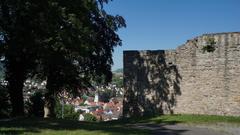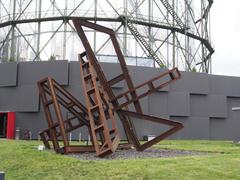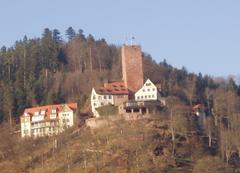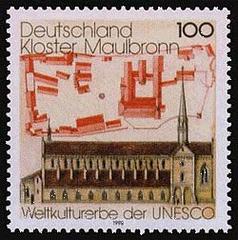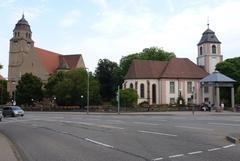
St. Michael Pforzheim: Visiting Hours, Tickets, and Historical Site Guide
Date: 04/07/2025
Introduction
St. Michael’s Church (Schloß- und Stiftskirche St. Michael) in Pforzheim, Germany, is a distinguished landmark that encapsulates the region’s medieval history, architectural innovation, and enduring cultural spirit. As both a testament to resilience and a repository of artistic heritage, St. Michael’s offers visitors a window into Pforzheim’s transformation from a Roman outpost to a vibrant city. This comprehensive guide provides essential information for planning your visit — including opening hours, ticket policies, accessibility, and highlights of the site’s remarkable history and art.
Table of Contents
- Early Foundations and Medieval Origins
- Architectural Evolution
- Reformation and Modern Period
- Surviving World War II and Restoration
- Artistic Highlights
- Urban Context and Symbolism
- Cultural Importance
- Visitor Information
- Visitor Tips
- FAQ
- Visual and Digital Resources
- Conclusion and Recommendations
- Sources
Early Foundations and Medieval Origins
Dating back to the 13th century, St. Michael’s Church is among Pforzheim’s oldest surviving ecclesiastical structures. Built during the city’s shift from Roman settlement (Portus) to a medieval hub, the church displays the architectural styles of both the Romanesque and early Gothic periods. Notable features include robust stone walls, rounded arches of the Romanesque westwork (circa 1220–1230), and the pointed windows and vaults that foreshadow the Gothic expansion (The Crazy Tourist).
Strategically located near the confluence of the Enz, Nagold, and Würm rivers, St. Michael’s also became the burial site for the Margraves of Baden, anchoring its significance in the city’s feudal and aristocratic history (Trip.com).
Architectural Evolution
Romanesque and Gothic Construction
The original Romanesque nave was extended over centuries as architectural tastes evolved. The Gothic expansion (1270–1475) introduced ribbed vaults, the choir, the Margarethenkapelle (St. Margaret’s Chapel), and a soaring tower. The high choir, completed by Hans Spryß von Zaberfeld, and the church’s intricate rood screen are masterpieces of late Gothic stonework (Tourist Places Guide).
Collegiate Church Status
As a collegiate church, St. Michael’s housed a chapter of canons. This role not only elevated its religious standing but also established it as an educational and cultural center, further deepening its roots in the region’s spiritual and political fabric.
Reformation and Modern Period
The Protestant Reformation in the 16th century transformed St. Michael’s from a Catholic to a Lutheran church. This shift mirrored Pforzheim’s emergence as a center for Protestant thought and education. The church’s interior was adapted to Protestant worship, with a focus on preaching and liturgical music.
Surviving World War II and Restoration
On February 23, 1945, Pforzheim was devastated by an air raid. St. Michael’s Church remarkably survived as the only major medieval structure left standing in the city, symbolizing hope and continuity (The Crazy Tourist). Post-war restoration preserved original stonework, repaired structural damage, and restored furnishings and stained glass. The church’s crypt, containing the tombs of the Margraves of Baden, remains a focal point for visitors (Trip.com).
Artistic Highlights
- Sculptural Treasures: The church features medieval sculptures such as keystone figures of St. Michael and Christ as Redeemer. The late Gothic rood screen, attributed to Hans Spryß, boasts intricate tracery and expressive figures.
- Stained Glass and Modern Art: Postwar windows by Klaus Arnold blend vibrant color and abstraction, while Valentin Feuerstein’s works in the Margarethenkapelle link spiritual and civic themes.
- Funerary Art: The church houses a collection of tombs and grave slabs, including the oldest from 1275 and the ornate tomb of Erhard Thorlinger (15th century).
- Organ and Music: The renowned organ, prized for its acoustics, is used in both services and concerts, making the church a hub for sacred and classical music.
Urban Context and Symbolism
Often called Pforzheim’s “stone history book,” St. Michael’s Church, together with the adjacent archive tower and remnants of the city wall, anchors the city’s historic heart. The nearby Luther Oak and Schloßberg area further enrich the church’s urban and symbolic significance.
Cultural Importance
St. Michael’s is not just a historical monument but an active parish and cultural venue, hosting concerts, art exhibitions, and community events. Its bells and organ music punctuate civic life, and the church remains a center for reconciliation and intercultural dialogue, especially significant given its postwar restoration (Pforzheim Tourist Information, Ökumenische Citykirche Pforzheim).
Visitor Information
Visiting Hours
- Monday to Saturday: 10:00 AM – 5:00 PM
- Sunday and Public Holidays: 12:00 PM – 5:00 PM
- Special Events: Hours may vary during services or holidays. Check the official website or contact the parish office before visiting.
Tickets and Entry Fees
- Admission: Free
- Donations: Welcomed for preservation
- Guided Tours: May require a small fee; advance booking recommended
Accessibility
- Wheelchair Access: Provided via side entrance
- Assistance: Available on request
- Restrooms: Accessible facilities nearby
Getting There and Parking
- Location: Schloßberg 10, 75172 Pforzheim, Germany — centrally located, well-signposted
- Public Transport: 5-minute walk from Pforzheim central bus and train stations
- Parking: Limited nearby; public garages within walking distance
Guided Tours and Special Events
- Guided Tours: Focused on history, architecture, and art; available by appointment and in multiple languages (source)
- Concerts and Exhibitions: Frequent events, including sacred music, jazz, and Advent celebrations
Digital and Virtual Resources
- Virtual Tour: 360° virtual tour available online
- Audio Guides: Accessible via the Audiala app
Visitor Tips
- Best Lighting: Visit early morning or late afternoon for optimal photography
- Dress Code: Modest attire recommended, especially during services
- Photography: Allowed, but flash and tripods may be restricted; observe posted signs
- Language: Most tours in German; English tours can be arranged in advance
- Nearby Attractions: Schmuckmuseum (Jewelry Museum), Museum Johannes Reuchlin, and Pforzheim Stadttheater
- City Safety: Pforzheim is safe and welcoming for all travelers (Housity.net, Hikersbay)
Frequently Asked Questions (FAQ)
Q: What are the visiting hours?
A: Monday–Saturday 10:00 AM–5:00 PM, Sunday and holidays 12:00 PM–5:00 PM; check for special event closures.
Q: Is there an admission fee?
A: No, but donations are appreciated. Some tours/events may have a fee.
Q: Are guided tours available in English?
A: Yes, with advance arrangement through Tourist Information Pforzheim.
Q: Is the church accessible for visitors with disabilities?
A: Yes, the main areas are wheelchair accessible; further assistance available upon request.
Q: Can I take photographs inside?
A: Generally yes, but avoid flash/tripods and check for restrictions during services.
Visual and Digital Resources
- Exterior and Interior Photos: Available on official tourism platforms and the church’s website
- Virtual Tour: 360° virtual experience
- Audiala App: For audio guides and interactive maps
Conclusion and Recommendations
St. Michael’s Church is a living symbol of Pforzheim’s resilience, artistic achievement, and communal spirit. Its free admission, central location, and wealth of historical and artistic treasures make it a must-visit for anyone interested in history, architecture, or culture. Enhance your visit by booking a guided tour, exploring the virtual tour, or attending one of the many concerts and exhibitions. Stay updated on events and visiting hours via official sources and the Audiala app. Let St. Michael’s inspire your journey through Pforzheim’s rich heritage.










